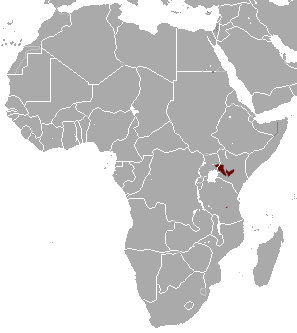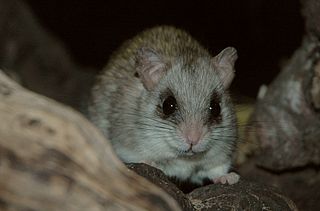
A genet is a member of the genus Genetta, which consists of 17 species of small African carnivorans. The common genet is the only genet present in Europe and occurs in the Iberian Peninsula, Italy and France.

The crested servaline genet, also known as the crested genet, is a genet species endemic to Nigeria and Cameroon. As the population has declined due to loss of habitat, it is listed as Vulnerable on the IUCN Red List. It was first recorded in the Mamfe Division in Cameroon and initially considered a subspecies of the servaline genet. But now it is regarded as a distinct species.

Jackson's mongoose is a mongoose species native to montane forests in Kenya, Uganda and Tanzania. It appears to be rare and has been classified as Near Threatened since 2008.
The medium-tailed brush-furred rat is a species of rodent in the family Muridae. It has been recorded from the Democratic Republic of the Congo, Rwanda, and Uganda. It lives in rainforest and swamps. It is a rare species which is threatened by habitat loss.
The Guinea multimammate mouse is a species of rodent in the family Muridae found in Benin, Burkina Faso, Burundi, Cameroon, the Central African Republic, Chad, the Republic of the Congo, the Democratic Republic of the Congo, Ivory Coast, Ethiopia, Gambia, Ghana, Guinea, Guinea-Bissau, Kenya, Liberia, Mali, Mauritania, Morocco, Niger, Nigeria, Rwanda, Senegal, Sierra Leone, Sudan, Togo, and Uganda. Its natural habitats are subtropical or tropical dry forests, dry savanna, moist savanna, subtropical or tropical dry shrubland, subtropical or tropical moist shrubland, arable land, rural gardens, urban areas, and irrigated land. They weigh between 12 and 105 grams.
Barbour's vlei rat is a species of rodent in the family Muridae. It is found in Kenya and Uganda. Its natural habitat is subtropical or tropical high-altitude shrubland. It is threatened by habitat loss.
The Uzungwe vlei rat is a species of rodent in the family Muridae. It is found in Malawi, Tanzania, and Zambia. Its natural habitats are subtropical or tropical high-altitude grassland and swamps. It is threatened by habitat loss.
The bell groove-toothed swamp rat is a species of rodent in the family Muridae found in Angola and the Democratic Republic of the Congo. Its natural habitats are moist savanna, subtropical or tropical dry lowland grassland, arable land, and rural gardens.
Pelomys is a genus of rodent in the family Muridae endemic to Africa. It contains the following species:
The creek groove-toothed swamp rat is a species of rodent in the family Muridae. It is found in Angola, Burundi, Democratic Republic of the Congo, Kenya, Malawi, Mozambique, Namibia, Rwanda, Tanzania, Uganda, Zambia, and Zimbabwe. Its natural habitats are moist savanna and pastureland.
Issel's groove-toothed swamp rat is a species of rodent in the family Muridae. It is found only in Uganda. Its natural habitats are arable land and rural gardens. It is threatened by habitat loss.
The least groove-toothed swamp rat is a species of rodent in the family Muridae. It is found in Angola, Democratic Republic of the Congo, Tanzania, and Zambia. Its natural habitat is moist savanna.

Loring's rat is a species of rodent in the family Muridae. It is found in Kenya and Tanzania. Its natural habitats are subtropical or tropical dry forests, dry savanna, and subtropical or tropical dry shrubland.

The acacia rat, or black-tailed tree rat, is a species of rodent in the family Muridae. It is a small arboreal rodent that is extensively dependent on Acacia trees. It is found in Botswana, Democratic Republic of the Congo, Ethiopia, Kenya, Malawi, Mozambique, Namibia, Somalia, South Africa, Eswatini, Tanzania, Zambia, and Zimbabwe. Its natural habitat is subtropical or tropical dry shrubland.
The Bukovina blind mole-rat or (erroneously) the Balkan blind mole-rat is a species of rodent in the family Spalacidae found in Romania, Moldova, and Ukraine.

The volcano shrew is a species of mammal in the family Soricidae found in the high-altitude rainforest of Burundi, eastern Democratic Republic of the Congo, Rwanda, and Uganda. Its natural habitats are subtropical or tropical moist montane forests and swamps. Its type locality is at Karisoke in Rwanda.
George Henry Evans Hopkins OBE was an English entomologist.

Arvicanthini is a tribe of muroid rodents in the subfamily Murinae. Almost all recent species in this tribe are or were found in Africa aside from one species, the Indian bush rat, which is found in South Asia and Iran. However, some fossil Golunda species from India and the genus Parapelomys are thought to have also occurred outside Africa, and one species in the fossil genus Saidomys may have also occurred in Afghanistan.







